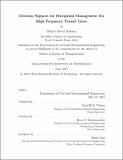| dc.contributor.advisor | Nigel H.M. Wilson and Haris N. Koutsopoulos. | en_US |
| dc.contributor.author | Babany, Michel David | en_US |
| dc.contributor.other | Massachusetts Institute of Technology. Department of Civil and Environmental Engineering. | en_US |
| dc.coverage.spatial | e-uk-en | en_US |
| dc.date.accessioned | 2015-10-30T18:34:45Z | |
| dc.date.available | 2015-10-30T18:34:45Z | |
| dc.date.copyright | 2015 | en_US |
| dc.date.issued | 2015 | en_US |
| dc.identifier.uri | http://hdl.handle.net/1721.1/99549 | |
| dc.description | Thesis: S.M., Massachusetts Institute of Technology, Department of Civil and Environmental Engineering, 2015. | en_US |
| dc.description | This electronic version was submitted by the student author. The certified thesis is available in the Institute Archives and Special Collections. | en_US |
| dc.description | Cataloged from student-submitted PDF version of thesis. | en_US |
| dc.description | Includes bibliographical references (pages 155-159). | en_US |
| dc.description.abstract | Incidents (due to equipment failures, passenger emergencies, infrastructure problems, human errors, etc.) routinely occur in metro systems. Such incidents can cause significant disruptions in service (from slowdown to full closure of the line), with serious impacts on passengers, especially in the core of high frequency lines operating near capacity. Disruption consists of two distinct phases. The incident phase is the period from the start of the incident to the moment when its cause has been resolved. The second phase of the disruption is the recovery, which starts at the end of the incident and lasts until normal service is restored. Dealing efficiently with disruptions is crucial and agencies use real-time control strategies to mitigate those impacts and improve performance. This thesis proposes an approach for supporting controllers decision-making in the recovery phase of disruption management. While the method is applied to the Piccadilly Line on the London Underground, It is applicable to other high frequency transit rail lines. After reviewing the main challenges controllers face during incident management and the main strategies they use, the thesis formulates the recovery phase problem as an optimization problem that integrates timetable revision and crew rescheduling (train reformation problem, TRP). The approach focuses on modeling common control strategies such as short-turning and train renumbering. It explicitly incorporates the scarcity of resources and associated constraints, especially with respect to crews. The method consists of two phases: the generation of a large number of candidate journeys; and the selection of the journeys (recovery timetable) that optimize some measure of performance, involving the effectiveness of the recovery and the passenger service. The model is first applied to an incident that happened on January 2014 on the Piccadilly Line. The actual controllers response is compared with the output of the train reformation problem, and a sensitivity analysis of the model parameters is performed. The results suggest that using more complex reformations and less short-turns may lead to better passenger service during the recovery phase. The train reformation problem is then applied to a hypothetical incident. The results support current practices that canceling trains during the incident phase enables a shorter and more efficient recovery. | en_US |
| dc.description.statementofresponsibility | by Michel David Babany. | en_US |
| dc.format.extent | 159 pages | en_US |
| dc.language.iso | eng | en_US |
| dc.publisher | Massachusetts Institute of Technology | en_US |
| dc.rights | M.I.T. theses are protected by copyright. They may be viewed from this source for any purpose, but reproduction or distribution in any format is prohibited without written permission. See provided URL for inquiries about permission. | en_US |
| dc.rights.uri | http://dspace.mit.edu/handle/1721.1/7582 | en_US |
| dc.subject | Civil and Environmental Engineering. | en_US |
| dc.title | Decision support for disruption management on high frequency transit lines | en_US |
| dc.type | Thesis | en_US |
| dc.description.degree | S.M. | en_US |
| dc.contributor.department | Massachusetts Institute of Technology. Department of Civil and Environmental Engineering | |
| dc.identifier.oclc | 925486771 | en_US |
